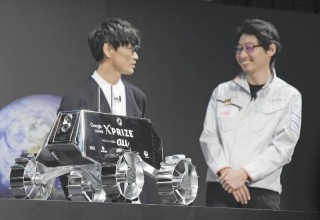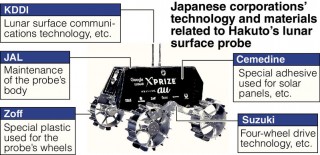Loading
Search
▼ Private Sector Readies Moon Probe
- Category:Other
A model of an unmanned moon probe has been unveiled in Tokyo, with the actual vehicle scheduled to compete in an international race to explore the lunar surface.
The probe is being designed by the Hakuto team from Japan’s private sector and will likely be finished by the end of January next year. It is expected to be launched into space from the United States in 2017.
The four-wheel probe is 58 centimeters long and weighs four kilograms. Unveiled on Monday, it is designed to withstand the radiation and heat of the lunar surface.
It also weighs about three kilograms less than a probe built earlier on an experimental basis, as it will cost about ¥120 million per kilogram to launch such a probe.
Starting Sept. 26, the probe will be run in a weeklong test drive on the Tottori Sand Dunes in Tottori Prefecture.
A prize of $20 million (about ¥2 billion) will be awarded to the winner of the international race. The Hakuto team comprises such personnel as engineers and other staff from various corporations. “Through trial and error, we’re getting closer to the moon one step at a time,” Hakuto leader Takeshi Hakamada said.
From late this month, the model probe will be exhibited as part of “The Universe and Art,” an exhibition sponsored by The Yomiuri Shimbun and others, at the Mori Art Museum in Roppongi district of Minato Ward, Tokyo.
Technology to be tested
The lunar surface exploration race is sponsored by Google Inc. of the United States, and will involve exploration vehicles from various nations. Hakuto’s probe is the result of technological development by such Japanese corporations as KDDI Corp., Suzuki Motor Corp., and Japan Airlines Co.
Hakuto’s probe will be launched into space by the end of next year. A focus of attention is whether the technical strength of Japanese companies will produce results on the surface of the moon, observers said.
The race will test lunar surface exploration vehicles developed through private-sector funds. After landing their probes on the moon, the competing teams will have to run them on the lunar surface for more than 500 meters while also having them transmit images of the lunar surface to the Earth. The winner will be decided by seeing which team is the first to achieve those goals by the deadline set at the end of 2017.
Sixteen teams will participate, including Japan, the United States, India, Germany and Israel.
The Hakuto team comprises just under 100 personnel, including robotics experts, corporate engineers and volunteers. The team has attached great importance to building a downsized probe and reducing its weight, given that the heavier it is, the greater the launching costs will be.
Hakuto’s vehicle weighs four kilograms, overwhelmingly lighter than its U.S. rival, which weighs about 30 kilograms.
Seven Japanese corporations are chiefly assisting in the probe’s development at the present time, each drawing on its own area of expertise.
For example, KDDI is providing the technology needed to prevent an interruption in communications on the lunar surface and also to restore images of the lunar surface that are damaged when transmitted from the moon. Suzuki is using its four-wheel drive and other technology to help the probe run steadily.
The probe’s body is made of carbon-fiber enforced plastic, a light and strong material used to build the body of aircraft. JAL’s airplane maintenance technology is being used to conduct work related to the explorer’s body.
The probe’s wheels are made of a light, sturdy special plastic, a material used in frames by the Zoff chain of eyeglasses stores. The company that operates the Zoff chain has extended financial assistance for the probe’s development.
The probe needs to be physically strong to withstand the severe environment on the surface of the moon. Adhesive agent manufacturer Cemedine Co. is working with the project to develop an adhesive to be used on the vehicle’s body in space, to fasten a solar panel and other equipment to the probe.
“We want to support [Hakuto’s project as] a spectacular challenge,” KDDI President Takashi Tanaka said at the event held to unveil the model probe. JAL President Yoshiharu Ueki said, “As a pilot, I’ve worked closer to the moon than anybody.”
“[The probe] is a new challenge [taken on in exploring] the moon. We cannot fall behind in achieving that dream,” Ueki said.
The lunar surface exploration race is sponsored by Google Inc. of the United States, and will involve exploration vehicles from various nations. Hakuto’s probe is the result of technological development by such Japanese corporations as KDDI Corp., Suzuki Motor Corp., and Japan Airlines Co.
Hakuto’s probe will be launched into space by the end of next year. A focus of attention is whether the technical strength of Japanese companies will produce results on the surface of the moon, observers said.
The race will test lunar surface exploration vehicles developed through private-sector funds. After landing their probes on the moon, the competing teams will have to run them on the lunar surface for more than 500 meters while also having them transmit images of the lunar surface to the Earth. The winner will be decided by seeing which team is the first to achieve those goals by the deadline set at the end of 2017.
Sixteen teams will participate, including Japan, the United States, India, Germany and Israel.
The Hakuto team comprises just under 100 personnel, including robotics experts, corporate engineers and volunteers. The team has attached great importance to building a downsized probe and reducing its weight, given that the heavier it is, the greater the launching costs will be.
Hakuto’s vehicle weighs four kilograms, overwhelmingly lighter than its U.S. rival, which weighs about 30 kilograms.
Seven Japanese corporations are chiefly assisting in the probe’s development at the present time, each drawing on its own area of expertise.
For example, KDDI is providing the technology needed to prevent an interruption in communications on the lunar surface and also to restore images of the lunar surface that are damaged when transmitted from the moon. Suzuki is using its four-wheel drive and other technology to help the probe run steadily.
The probe’s body is made of carbon-fiber enforced plastic, a light and strong material used to build the body of aircraft. JAL’s airplane maintenance technology is being used to conduct work related to the explorer’s body.
The probe’s wheels are made of a light, sturdy special plastic, a material used in frames by the Zoff chain of eyeglasses stores. The company that operates the Zoff chain has extended financial assistance for the probe’s development.
The probe needs to be physically strong to withstand the severe environment on the surface of the moon. Adhesive agent manufacturer Cemedine Co. is working with the project to develop an adhesive to be used on the vehicle’s body in space, to fasten a solar panel and other equipment to the probe.
“We want to support [Hakuto’s project as] a spectacular challenge,” KDDI President Takashi Tanaka said at the event held to unveil the model probe. JAL President Yoshiharu Ueki said, “As a pilot, I’ve worked closer to the moon than anybody.”
“[The probe] is a new challenge [taken on in exploring] the moon. We cannot fall behind in achieving that dream,” Ueki said.
- September 2, 2016
- Comment (0)
- Trackback(0)



